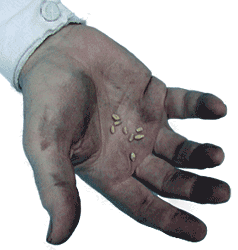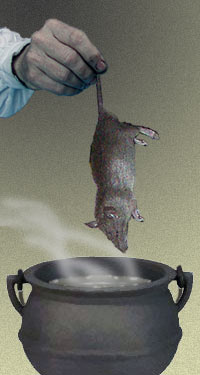 |
"Awful Madness of Hunger" |
 Cannon
and mortar fire had at times prompted commanders of forts to call
for talks - so did attrition by starvation and disease, which was
gradual but relentless. Should the siege go so far as the
final assault, many defending soldiers and trapped civilians were not
anxious about being killed - they were already dead.
Jean de Levy, a Huguenot minister, wrote that during the eight-month
siege in 1573 of Sancerre in France 84 people died from
battle-related causes whereas more than 500 starved to death, as
many as 30 a day at the worst. Perhaps as many as 30,000 perished in
the Siege of Paris 17 years later.
Cannon
and mortar fire had at times prompted commanders of forts to call
for talks - so did attrition by starvation and disease, which was
gradual but relentless. Should the siege go so far as the
final assault, many defending soldiers and trapped civilians were not
anxious about being killed - they were already dead.
Jean de Levy, a Huguenot minister, wrote that during the eight-month
siege in 1573 of Sancerre in France 84 people died from
battle-related causes whereas more than 500 starved to death, as
many as 30 a day at the worst. Perhaps as many as 30,000 perished in
the Siege of Paris 17 years later.
 Of
course, anything that could be swallowed was. After wheat and rye flour
was consumed, barley, then oats followed. Along the way, after the supply
of cattle, pigs and sheep had been eaten, horses, then donkeys came next.
When grain foods gave out, people turned to grinding bones. Any plants,
including grass, that weren't poisonous went into their mouths. Dogs and
cats were chased down and killed, then rats and mice trapped. Boiled leather,
parchment and even feces followed. Any found food sold for inflated - then
extreme - prices.
Of
course, anything that could be swallowed was. After wheat and rye flour
was consumed, barley, then oats followed. Along the way, after the supply
of cattle, pigs and sheep had been eaten, horses, then donkeys came next.
When grain foods gave out, people turned to grinding bones. Any plants,
including grass, that weren't poisonous went into their mouths. Dogs and
cats were chased down and killed, then rats and mice trapped. Boiled leather,
parchment and even feces followed. Any found food sold for inflated - then
extreme - prices.
Defenders tried whatever they could to get food. Blaise de Monluc described at the siege of Siena, 1555: "...little and little we lost several inhabitants and soldiers, who fell down dead as they walked the streets, so that they died without sickness, At last the physicians found it out that it was the mallows they fed upon... Now we had no other herbs all along the walls of the city, they having been eaten before, neither could we come by these without sallying out to skirmish, and then all the women and children of the town went out to gather them. But I saw I lost so many men in these skirmishes that I would not permit anyone to sally out."
The light-headedness associated with lack of calories was accompanied by changes in personal attitudes, sometimes extreme. Some defenders became more intense in their faiths, others fatalistic or mystical, still others questioned beliefs and ethics held for years. Not surprising, starving defenders may have had second thoughts about continuing their obstinate resistance. To encourage (or shame) defenders of Leiden to hold on a little longer in 1574, their mayor offered himself for food. Cannibalism was reported: Sancerre in 1573 and Paris in 1590. Of Paris: "... two or three days before the siege was lifted, some soldiers, people completely barbarous and inhuman, dying of awful madness of hunger, began to chase after children as if they were dogs, and ate three of them..."
Hallucinations, too, floated up. During the Siege of Paris, some men of the Duke of Savoy were frightened by perceiving poisonous snakes writhing down the streets.
Lack of calories was only part of starvation. So were vitamin deficiencies. No fruit and vegetables to provide vitamin C and scurvy set in, with blackened and bleeding gums, easy bruising, and even teeth falling out, followed by debilitation and collapse. Without vitamin A, night blindness limited the soldier and rendered him more vulnerable to disease. But any body weakened by lack of food was an open invitation to disease organisms. A prolonged siege provided a wealth of opportunity for disease.
| Back | Disease |
|
|
|